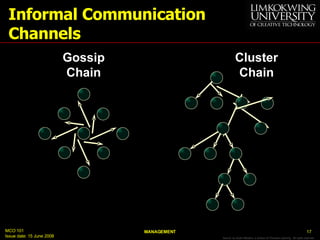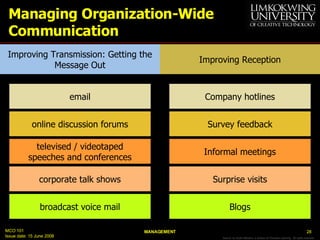MBA MCO101 Unit 9 Lecture 10 200806 Xx
- 2. Managing Expectations LEARNING OUTCOMES: At the end of the course, students will be able to: Explain fundamental concepts and principles of management including the basic roles, skills, and functions of management Discuss the knowledgeable of historical development, theoretical aspects and practice application of managerial process Examine the environment, technology, human resources, and organisations in order to achieve high performance Discuss the ethical dilemmas faced by managers and the social responsibilities of businesses.
- 3. Managing Expectations SUBJECTS DISCUSSED: Management, Managers and evolution of Management theory Personality traits and diversity Organisation, Globalisation and the resulting environments Decision-making and Planning Structure and Strategy Executing and Controlling Human Resources Management as a function Motivation, Leadership, Groups and Teams Communication Operations Management. Entrepreneurship. Innovation
- 4. Managing Expectations TOPIC DETAILS: After going through UNIT 9, you should be able to: explain the role that perception plays in communication and communication problems. describe the communication process and the various kinds of communication in organizations. explain how managers can manage effective one-on-one communication. describe how managers can manage effective organization-wide communication.
- 5. Perception and Communication Problems Basic Perception Process Perception Problems Perceptions of Others Self-Perception
- 6. Basic Perception Process Perception The process by which individuals attend to, organize, interpret, and retain information from their environments. Perception Filters The personality-, psychology-, or experienced-based differences that influence people to ignore or pay attention to particular stimuli.
- 7. Perception Problems Selective perception (self) notice and accept stimuli which are consistent with our values and beliefs; ignore inconsistent stimuli Closure (self) tendency to fill in the gaps when information is missing; we assume that what we don’t know is consistent with what we do know Self-Serving Bias The tendency to overestimate our value by attributing successes to ourselves (internal causes) and attributing failures to others or the environment (external causes). Attribution Theory (others): we have a need to understand and explain the causes of other people’s behavior General reasons to explain behavior: Internal attribution - the behavior was voluntary or under their control; External attribution - the behavior was involuntary and beyond their control
- 8. Attribution Bias and Error Defensive Bias Fundamental Attribution Error The tendency for people to perceive themselves as personally and situationally similar to someone who is having difficulty. The tendency to ignore external causes of behavior and to attribute other people’s actions to internal causes.
- 9. Attribution Bias and Error
- 10. Kinds of Communication Communication Process Formal Communication Channels Informal Communication Channels Coaching and Counseling Nonverbal Communication
- 11. The Interpersonal Communication Process Encode Message Decode Message N o i s e N o i s e N o i s e N o i s e Transmit Message Receive Message Message to be Conveyed Message that was Understood Sender Receiver Communication Channel Feedback to Sender
- 12. The Communication Process The sender is unsure what message to communicate The message is not clearly encoded The wrong channel is chosen The message is improperly decoded The receiver lacks experience or time Noise occurs if: Meanings of the Word minute ?
- 13. Formal Communication Channels The system of official channels Downward communication - top down Upward communication - bottom up Horizontal - within a level Improving Formal Communication Decrease reliance on downward communication Increase chances for upward communication Encourage much greater use of horizontal communication Be aware of communication problems
- 14. Common Problems with Downward, Upward, and Horizontal Communication Downward Sending too many messages Issuing contradictory messages Hurriedly communicating vague, unclear messages Issuing messages indicating management’s low regard for lower-level workers Upward Risk of telling upper management about problems Managers acting angrily and defensively to problems Few opportunities for workers to contact upper levels of management Horizontal Management discouraging or punishing horizontal communication Managers and workers not given time or opportunity for horizontal communication Not enough opportunities or channels for lower-level workers to engage in horizontal communication
- 15. Informal Communication Channels Transmitting messages outside the formal communication channels The “Grapevine” Highly accurate information is timely senders seek feedback accuracy can be verified
- 17. Informal Communication Channels Gossip Chain Cluster Chain
- 18. Managing Organizational Grapevines Don’t withhold information from it Don’t punish those who use it Embrace the grapevine and keep employees informed Use it as a source of information
- 19. Informal Communication Channels 1. Correct misinformation. 2. Don’t take angry comments personally 3. Give your name and contact number 4. Hold a town meeting to discuss issues 5. Set up anonymous discussion forums Dealing with Internet Gripe Sites
- 20. Nonverbal Communication Any communication that doesn’t involve words Kinesics movements of the body and face Paralanguage the pitch, tone, rate, volume, and speaking pattern of a person’s voice
- 21. How to Improve Communication Choosing the Right Communication Medium Being a good listener Giving effective feedback Improving cross-cultural communication
- 22. Communication Medium & Listening Communication Medium The method used to deliver an oral or written message, oral communication and or written communication Listening Clarify responses: ask questions to clear up ambiguities Paraphrase responses: restate the speaker’s comments in your own words Summarize responses: review the speaker’s main points Show your desire to understand : listen first, talk about what’s important to the other Reflect feelings : focus on the emotional part of the message, more than just restating words Hearing versus Listening Active Listening Emphatic Listening
- 23. Making Feedback Constructive Give immediate feedback don’t delay feedback discuss performance while the memory is vivid Make feedback specific focus on definite behavior and time-frame make sure behavior was controllable Make feedback problem-oriented focus on behavior not personality The reverse would be destructive!
- 24. Improving Cross-Cultural Communication 1. Familiarize yourself with a culture’s work norms 2. Know whether a culture is emotionally affective or neutral 3. Understand terms and attitudes toward time
- 25. Affective and Neutral Cultures Reveal thoughts and feelings through verbal and nonverbal communication Express and show feelings of tension Let their emotions flow easily, intensely, and without inhibition Admire heated, animated, and intense expressions of emotion Are used to touching, gesturing, and showing strong emotions through facial expressions Make statements with emotion Don’t reveal what they are thinking or feeling Hide tension and only show it accidentally in face or posture Suppress emotions, leading to occasional “explosions” Admire remaining cool, calm, and relaxed Resist touching, gesturing, and strong emotions through facial expressions Often make statements in an unexpressive manner In Affective Cultures, People… In Neutral Cultures, People…
- 26. Monochronic and Polychronic Cultures Do one thing at a time Concentrate on the job Take time commitments seriously Are committed to the job Adhere religiously to plans Show respect for private property Emphasize promptness Are accustomed to short-term relationships Do many things at once Are highly distractible and subject to interruptions Meet time commitments only if possible without extreme measures Are committed to people Change plans easily and often Are more concerned with relationships than with privacy Frequently borrow and lend things Vary promptness by the relationship Tend to build lifetime relationships People in Monochronic Cultures… People in Polychronic Cultures…
- 27. Cross-Cultural Temporal Concepts Appointment time how punctual you must be Schedule time time when projects should be completed Discussion time how much time should be spent in discussions Acquaintance time how much small-talk is required
- 28. Managing Organization-Wide Communication Improving Transmission: Getting the Message Out Improving Reception Company hotlines Survey feedback Informal meetings Surprise visits Blogs email online discussion forums televised / videotaped speeches and conferences corporate talk shows broadcast voice mail




























